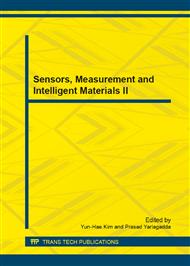[1]
Yick J, Mukherjee B, Ghosal D. Wireless sensor network survey. Computer Networks, 2008, 52(12): 2292–2330.
DOI: 10.1016/j.comnet.2008.04.002
Google Scholar
[2]
Abbasi A, Younis M. A survey on clustering algorithms for wireless sensor networks. Computer Communications, 2007, 30(14-15): 2826–2841.
DOI: 10.1016/j.comcom.2007.05.024
Google Scholar
[3]
Bollobas B. Random Graphs. [S. 1. ]: Academic Press, (1985).
Google Scholar
[4]
Wang D W, Yung K L, Ip W H. A Heuristic Genetic Algorithm for Subcontractor Selection in a Global Manufacturing Environment. IEEE Trans. SMC Part-C, 2001, 31(2): 189-198.
DOI: 10.1109/5326.941842
Google Scholar
[5]
Kulkarni R, Venayagamoorthy G. Particle Swarm Optimization in Wireless Sensor Networks: A Brief Survey. IEEE Trans. Systems, Man & Cybernetics, 2011, 41(2): 262-267.
DOI: 10.1109/tsmcc.2010.2054080
Google Scholar
[6]
Li Xd. Niching Without Niching Parameters: Particle Swarm Optimization Using a Ring Topology. IEEE Trans Evol. Comput., 2010, 14(1): 150-169.
DOI: 10.1109/tevc.2009.2026270
Google Scholar
[7]
Latiff N, Tsimenidis C, Sharif B. Performance comparison of optimization algorithms for clustering in wireless sensor networks. Proc IEEE Int. Conf. Mobile Ad Hoc Sens. Syst. 2007: 1–4.
DOI: 10.1109/mobhoc.2007.4428638
Google Scholar
[8]
Xu R, Xu J. A Comparison Study of Validity Indices on Swarm-Intelligence-Based Clustering. IEEE Trans. Systems, Man & Cybernetics, 2012, 42(4): 1243-1256.
DOI: 10.1109/tsmcb.2012.2188509
Google Scholar
[9]
Latiff N, Tsimenidis C, Sharif B. Energy-aware clustering for wireless sensor networks using particle swarm optimization. Proc IEEE PIMRC, 2007: 1-5.
DOI: 10.1109/pimrc.2007.4394521
Google Scholar
[10]
Liang Y, Yu H B, Zeng P. Optimization of clusterbased routing protocols in wireless sensor network using PSO. Control & Decision, 2006, 21(4): 453-456.
Google Scholar
[11]
Heinzelman W B, Chandrakasan A P, Balakrishnan H. An Application-Specific Protocol Architecture for Wireless Microsensor Networks. IEEE Trans. Wireless Commun., 2002, 1(4): 660–770.
DOI: 10.1109/twc.2002.804190
Google Scholar
[12]
Rappaport T. Wireless Communications: Principles & Practice. New Jersey: Prentice-Hall, 1996: 87-98.
Google Scholar
[13]
Kennedy J, Eberhart R. Particle swarm optimization. Proc IEEE Int. Conf. Neural Netw. 1995: 1942–(1948).
Google Scholar
[14]
Li C, Yang S, Nguyen T. A Self-Learning Particle Swarm Optimizer for Global Optimization Problems. IEEE Trans. Systems, Man & Cybernetics, 2012, 42(3): 627-646.
DOI: 10.1109/tsmcb.2011.2171946
Google Scholar


